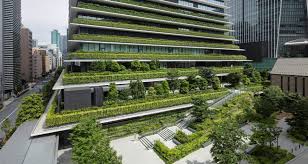The Rise of Urban Green Architecture
Urban green architecture is a rapidly growing trend that is revolutionising the way we design and build our cities. This innovative approach combines sustainable design principles with the integration of green spaces to create healthier and more environmentally friendly urban environments.
One of the key aspects of urban green architecture is the incorporation of vegetation into the built environment. This can include green roofs, vertical gardens, and living walls that not only enhance the aesthetic appeal of buildings but also provide numerous environmental benefits. These green elements help to reduce urban heat island effect, improve air quality, and promote biodiversity in densely populated areas.
Furthermore, urban green architecture plays a crucial role in mitigating the impacts of climate change. By increasing greenery in cities, we can combat rising temperatures, reduce energy consumption for cooling buildings, and enhance overall resilience to extreme weather events.
Architects and urban planners are embracing this sustainable approach to design by incorporating biophilic elements that connect people with nature within urban settings. This not only creates more pleasant and inviting spaces for residents but also contributes to their physical and mental well-being.
In addition to environmental and health benefits, urban green architecture also has economic advantages. Green buildings are often more energy-efficient, which leads to cost savings for building owners over time. Moreover, properties with green features tend to have higher market value and attract tenants who value sustainability.
As we continue to face challenges related to rapid urbanisation and climate change, urban green architecture offers a promising solution for creating greener, more liveable cities. By prioritising sustainability and integrating nature into our built environment, we can pave the way for a more resilient and harmonious urban future.
Six Essential Tips for Enhancing Urban Green Architecture
- Incorporate green roofs to reduce heat absorption and improve insulation.
- Use native plants in landscaping to promote biodiversity and require less maintenance.
- Implement rainwater harvesting systems to irrigate green spaces and reduce water consumption.
- Design buildings with natural ventilation systems to enhance air quality and reduce energy usage.
- Integrate vertical gardens on building facades to increase greenery in urban areas.
- Utilise sustainable materials like recycled wood or eco-friendly insulation for construction.
Incorporate green roofs to reduce heat absorption and improve insulation.
Incorporating green roofs is a smart strategy in urban green architecture to combat heat absorption and enhance insulation within buildings. By adding vegetation to rooftops, not only do we create visually appealing spaces, but we also significantly reduce the amount of heat that buildings absorb, thus lowering energy consumption for cooling. Green roofs act as natural insulators, helping to regulate indoor temperatures and reduce the need for artificial heating or cooling systems. This simple yet effective technique not only contributes to energy efficiency but also promotes sustainability and environmental resilience in urban environments.
Use native plants in landscaping to promote biodiversity and require less maintenance.
Using native plants in landscaping is a key tip in urban green architecture as it promotes biodiversity and requires less maintenance. Native plants are well-adapted to the local climate and soil conditions, making them more resilient to fluctuations in weather and reducing the need for excessive watering or chemical inputs. By incorporating native species into urban landscapes, architects and planners can create habitats that support a diverse range of wildlife, from pollinators to birds, enhancing the overall ecological balance of the area. Additionally, native plants help to preserve the unique character of the region’s flora and fauna, contributing to a sense of place and identity within the urban environment.
Implement rainwater harvesting systems to irrigate green spaces and reduce water consumption.
Implementing rainwater harvesting systems is a sustainable practice in urban green architecture that offers dual benefits. By collecting rainwater to irrigate green spaces, cities can reduce their reliance on potable water sources for landscaping needs, thus conserving precious resources. This approach not only helps to sustain the vitality of green areas but also contributes to water conservation efforts, promoting a more environmentally responsible urban environment.
Design buildings with natural ventilation systems to enhance air quality and reduce energy usage.
Designing buildings with natural ventilation systems is a key strategy in urban green architecture to improve air quality and decrease energy consumption. By incorporating features that allow for the flow of fresh air without relying solely on mechanical systems, such as windows that can be opened or atriums that promote air circulation, architects can create healthier indoor environments while reducing the need for artificial cooling or heating. This approach not only benefits occupants by providing a constant supply of fresh air but also contributes to the overall sustainability of the building by lowering energy usage and operating costs.
Integrate vertical gardens on building facades to increase greenery in urban areas.
Integrating vertical gardens on building facades is a smart and effective strategy to enhance greenery in urban areas. By utilising vertical space for vegetation, cities can maximise their green footprint without sacrificing valuable ground space. These living walls not only add a touch of natural beauty to the urban landscape but also offer environmental benefits such as improved air quality, biodiversity support, and thermal insulation for buildings. Embracing this approach to urban green architecture can transform concrete jungles into vibrant and sustainable living environments that benefit both residents and the planet.
Utilise sustainable materials like recycled wood or eco-friendly insulation for construction.
When incorporating urban green architecture principles, it is essential to utilise sustainable materials such as recycled wood and eco-friendly insulation for construction. By choosing these environmentally conscious materials, not only can we reduce the demand for new resources but also minimise the carbon footprint of buildings. Sustainable materials like recycled wood contribute to a circular economy and help in conserving natural resources, while eco-friendly insulation improves energy efficiency and reduces greenhouse gas emissions. Embracing such practices in construction aligns with the ethos of urban green architecture, promoting sustainability and creating healthier urban environments for both people and the planet.
